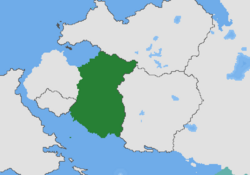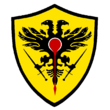Rothgard: Difference between revisions
No edit summary |
No edit summary |
||
| Line 108: | Line 108: | ||
<h3>18th Century</h3> | <h3>18th Century</h3> | ||
<h3>Modern History</h3> | <h3>Modern History</h3> | ||
<h2>Demographics</h2> | |||
<h2>Politics</h2> | |||
<h3>Government</h3> | |||
<h3>Military</h3> | |||
[[Rothgard Armed Forces]] | |||
Latest revision as of 10:24, 8 October 2022
Republic of Rothgard R̆xṭh kār̒d (Rothgan) Rothagia (Kakish) | |
|---|---|
| Motto: S̄āmạkhkhī pgp̂ax māterp̣hami (Rothgan) ("United to protect the motherland") | |
| Anthem: ("The first struggle") | |
 Rothgard in Thrismari | |
| Capital and largest city | Ostena |
| Official languages | Rothgan Common |
| Recognised Regional languages |
|
| Ethnic groups (2022) | see here
|
| Religion (2012) | see here
|
| Demonym(s) | Rothgan |
| Government | Unitary semi-presidential republic |
• President | Vallaro Sunthorn |
• Prime Minister | Tharit Juntasa |
| Legislature | Parliament |
| The Senate | |
| House of Representative | |
| Establishment history | |
• R̆xṭh kār̒d | ~ 1680s |
• Kakish Colony | 03 December 1922 |
• Independence | 09 April 1865 |
• Ersathri Constitution | 23 May 1930 |
• Modern Republic | 20 April 1981 |
| Population | |
• Estimate | |
• Census | 25,539,000 |
| GDP (nominal) | 2021 estimate |
• Total | (☧ 4.74e Pamar) |
• Per capita | (☧ 1,860,000 Pamar) |
| Gini (2020) | medium |
| HDI (2020) | high |
| Currency | Pamar (☧) |
• Summer (DST) | 0 |
| Date format | dd.mm.yyyy |
| Driving side | right |
| Calling code | +140 |
| ISO 3166 code | PMR |
| Internet TLD | .rth |
Rothgard is a sovereign country located in the northeast Thrismari bordering Inner Bammv Cite and Faragint with Nova Riata sea to the south. It has a population of 25,539,000 people with diverse culture and ethnicity spreading across the country. Its capital is Ostena, also the biggest city in the country.
Rothgard was inhabited by indigenous peoples from 3000 BCE. It was home to atleast 8 different major tribes/chiefdom for centuries such as the kār̒disan (native rothgan), Inthuras, Laddawan etc. Kakish colonizers arrived in the early to mid 18th century, eventually establishing colonies on the land. Altough they came peacefully, a slavery in the form of chattel slaves soon was enacted. Rothgard developed rapidly alongside Bammv Cite and became a suitable hub for trades from Southern Thuadia and Thrismari. The dominance of the segregation system, and slavery generated a wave of distrust emerged towards Kakish authority, causing the 1st war of independence war at 1812. The Kakish managed to quell the rebellion and the land was reorganized under the single administration of "Rothargia" with portion amount of territory secceded to Bammv Cite. Kakish rule would last until 1865 after the 2nd Independence war. Rothgard further suffered from two civil war both in 1920s and 1960s after coups and political turmoils.
The Anterian World Assembly designates Rothgard as a developing country. Although constitutionally a multi-party state, the political system de-facto centres around a single political party, the Phu Phitaks ("Orange Guide") Party. While per capita income remains low compared to most anterian countries, Rothgard has one of the fastest-growing economies in Thrismari. Agriculture remains the dominant economic sector, with strong growth in textiles, construction, garments, and tourism leading to increased foreign investment and international trade. Foreign observers have highlighted corruption, poverty and human rights as major issues in the country.
History
Pre-Colonization
Rothgard traces its history to the kingdom of R̆xṭh kār̒disan, which was founded in the 14th century by a Ra'x Fao, alongside the other 6 tribes: Warat, Inthura, Laddawan, Akrit Taira, Pnom-Hei, Kamp-chawan. Ra'x Fao, with 10,000 troops, conquered many indigenous principalities in the Lonna region, culminating in the capture of now called Ostena city. The kingdom was descended from a long line of tribesmen that traced back to 400 BC. He made Theravada Buddhism the state religion, and R̆xṭh kār̒disan prospered.
18th Century
Modern History
Demographics
Politics
Government
Military

